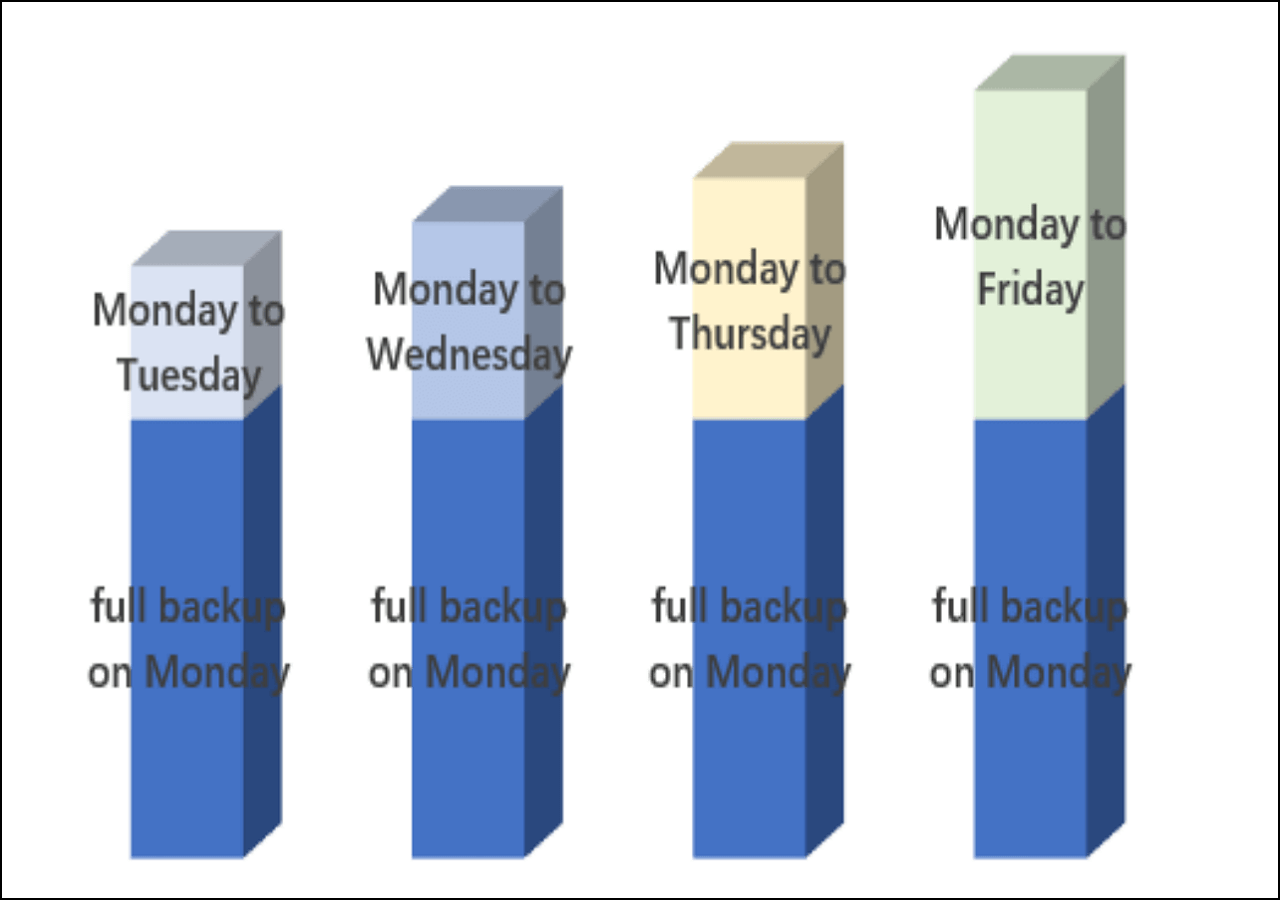What Is Differential Backup
Differential backup is one of the data backup methods, and it can backup files, folders, and hard drives. The differential backup starts with a full backup, so a differential backup depends on the full backup. It can copy all the data and files that have changed since the last full backup.
To better understand the differences between differential, full, and incremental backup, we provide you a 3-mins video.
There are 4 crucial timing points you may not want to miss.
- 00:24 Two important backup rules
- 00:42 An example to explain the differences
- 02:01 Features of full, incremental, and differential backup
- 02:44 How to create a better backup strategy
Why you choose differential backup
After a full backup, the data will change daily or weekly, and the disk space does not allow us to do full backups daily. That is why we need the differential backup. If you find backing up all your data daily impossible, your data will not change too much daily.
The differential backup may help you a lot. When you need to restore the data, use a full backup and the latest differential backup to do it.
What does a differential backup do
For example, if you did a full backup on Monday, Tuesday's backup backs up all the files added since Monday's full backup.
- Monday: A full backup is created. It contains ten files.
- Tuesday: You add two files and perform a differential backup. You will get two newly added image files.
- Wednesday: You add three files and perform a differential backup. You will get two image files you added on Tuesday and three newly added image files.

Full Backup VS Differential Backup
Full backup means copying all the data and files once a time. It is a well-known backup solution, many articles introduce full backup, and it is easiest to understand.
We need more time to make a full backup file, which may take up more space on your computer. A full backup is suited for a long-term situation like monthly.
Differential backup relies on full backup because it records the changes after the last full backup. It copies fewer data than the full backup, so you can frequently create a differential backup.Differential backup is still imperfection, and when the backup cycle gets longer, a differential backup gets closer to a full backup.

Incremental Backup VS Differential Backup
Incremental backup and differential backup are often mixed-up by people. Both of them copy the changing date, but there are differences. Incremental backup means copying the changing data after the last backup, which may include a full backup, a differential backup, or an incremental backup.
You need to back up a small amount of data once a time. The incremental backup file takes up a little space, and creating an incremental backup file won't take too much time. However, restoring the whole date with incremental backup is super complex. If one file is damaged, we can not recover all the data successfully.
If you finished a full backup on Sunday, then on Monday, an incremental backup only contained the changing data after Sunday. On Tuesday, the backup file contained the changing data after the previous incremental backup. Differential backup solves part of the problems that incremental backup has, and it reduces the probability of file corruption and is easier to restore files than an incremental backup.

Advantages and Disadvantages of Differential Backup
Differential backup is an excellent way to back up changing data, but it is not perfect. Here are some advantages and disadvantages of differential backup:
Advantages:
- Like incremental backup, a differential backup does not need to back up too much data or files as a full backup.
- It will not take too much time to finish a differential backup. Differential backup is a time-saving backup method.
- Differential backup is easy to restore. A differential backup still needs the previous full backup to operate.
Disadvantages:
- Not completely safe.
- The file may be damaged while a differential backup process.
- Although a differential backup is faster than a full backup, it takes less time to restore a full backup than a differential backup.
- The differential backup file will get larger and larger as time goes by, even getting bigger than the full backup.
Conclusion
Different backup methods have different features. It is hard to say which backup method is better because they are all useful in some situations.
This article explained the advantages and disadvantages of differential backup. It offers you the reasons to choose differential backup or not to choose it. If you are an enterprise user, a single backup method may not satisfy your need.
Use differential, incremental, and full backup to make your data safe.
Was This Page Helpful?
Daisy is the Senior editor of the writing team for EaseUS. She has been working at EaseUS for over ten years, starting as a technical writer and moving on to being a team leader of the content group. As a professional author for over ten years, she writes a lot to help people overcome their tech troubles.
Dany is an editor of EaseUS who lives and works in Chengdu, China. She focuses on writing articles about data recovery on Mac devices and PCs. She is devoted to improving her writing skills and enriching her professional knowledge. Dany also enjoys reading detective novels in her spare time.
Related Articles
-
How to Map a Network Drive in Windows 11? Your Complete Guide Is Here
 Tracy King/2024-01-11
Tracy King/2024-01-11 -
[PNG Files] What Is a PNG File? Everything You Should Know
 Jaden/2024-01-11
Jaden/2024-01-11 -
What is a Client Server Network? How Does It Work?
 Daisy/2024-01-11
Daisy/2024-01-11 -
Windows Command Line Cheat Sheet (Online Table and PDF)
 Daisy/2024-01-11
Daisy/2024-01-11
